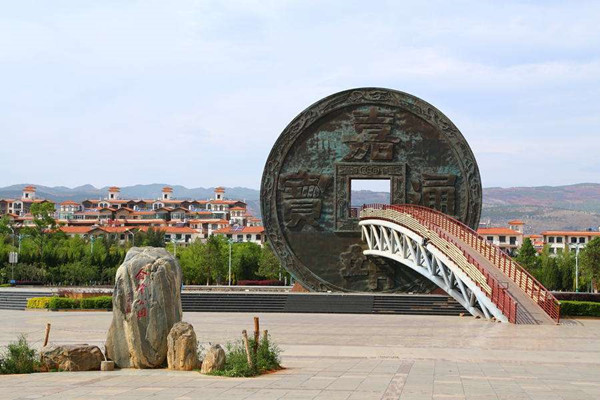
The Giant Coins in Huize County, Qujing
Chinese Name:会泽公园大铜钱
English Name:The Giant Coins in Huize County, Qujing
Overview
The Giant Coins in Huize County, Qujing, are located at Huize Park on Tongbao Road No. 366. This remarkable sculpture is a scaled-up version of an ancient Chinese coin, with a diameter of 22.6 meters and a weight of 77,777 kilograms. Designed by renowned architect Xie Bingman, the sculpture is an iconic landmark symbolizing Huize County’s rich copper heritage. The coin is magnified 39 times its original size and features a “rainbow bridge” that crosses a water body, creating an illusion of a time tunnel, representing Huize’s historical significance and its bright future.
Main Attractions
- Giant Coin Sculpture: This monumental coin sculpture is the centerpiece of Huize Park, symbolizing Huize County’s illustrious history of copper mining and coin production. Visitors can walk over the bridge that spans the coin’s central hole, offering a unique experience and scenic views.
- Coin Casting Offices: Huize County is home to two historical coin casting offices. The older office, known as “Baoyun,” dates back to the early years of the Yongzheng Emperor’s reign (1723-1735). The newer Baoyun office, built in 1741 during the Qianlong Emperor’s reign, occupies a significant area of 8,600 square meters and features a complex design with multiple halls, storage rooms, and furnaces.
- Architectural and Historical Significance: The architecture of the new coin casting office includes a front hall, a main hall, and a back hall. The back hall features a statue of an old man riding an ox, inspired by the saying “purple air comes from the east,” symbolizing prosperity and good fortune.
History
Huize County has been a hub for copper production for over 3,200 years, dating back to the late Zhou Dynasty. Two major peaks in copper trade and culture were observed: the first during the Eastern Han Dynasty (25-220 AD) and the second from the Kangxi to the Xianfeng Emperor’s reigns (1682-1856) during the Qing Dynasty. During this period, Huize became renowned for its copper mining, smelting, and coin casting, making it a vital economic center and earning the nickname “Copper Capital.”
Best Time to Visit
The best time to visit the Giant Coins in Huize County is during the spring and autumn months (March to May and September to November). The weather is mild and comfortable, making it ideal for exploring the park and its surroundings.
How to Get There
- By Car: Huize County is about 300 kilometers northeast of Kunming. Visitors can drive from Kunming via the G85 Expressway, which takes approximately four to five hours.
- By Bus: Regular buses run from Kunming to Huize County, with a travel time of around five hours. Once in Huize, local transportation options, such as taxis, are available to reach Huize Park.
Travel Tips
- Accommodation: Several hotels and guesthouses are available in Huize County, ranging from budget to mid-range options.
- Tour Maps: Visitors can find detailed maps of Huize Park and its attractions at the park’s entrance or the local tourism information center.
- Photography: The Giant Coin sculpture offers excellent photo opportunities, especially during sunrise and sunset.
Cultural Significance
The coin casting tradition in Huize County represents a rich cultural heritage that reflects the ingenuity and economic significance of copper mining in the region. The intricate designs and large-scale production of coins and other copper artifacts have contributed to Huize’s reputation as a center of craftsmanship and trade throughout Chinese history.
Conclusion
The Giant Coins in Huize County, Qujing, are not only a stunning visual landmark but also a testament to the region’s deep-rooted history in copper mining and coin casting. Visitors can immerse themselves in the rich cultural heritage, marvel at the architectural feats, and gain insight into the historical significance that has shaped Huize County into the “Copper Capital” it is known for today.

 7 Days GolfingTour
7 Days GolfingTour
 8 Days Group Tour
8 Days Group Tour
 8 Days Yunnan Tour
8 Days Yunnan Tour
 7 Days Shangri La Hiking
7 Days Shangri La Hiking
 11 Days Yunnan Tour
11 Days Yunnan Tour
 6 Days Yuanyang Terraces
6 Days Yuanyang Terraces
 11 Days Yunnan Tour
11 Days Yunnan Tour
 8 Days South Yunnan
8 Days South Yunnan
 7 Days Tea Tour
7 Days Tea Tour
 8 Days Muslim Tour
8 Days Muslim Tour
 12 Days Self-Driving
12 Days Self-Driving
 4 Days Haba Climbing
4 Days Haba Climbing
 Tiger Leaping Gorge
Tiger Leaping Gorge
 Stone Forest
Stone Forest
 Yunnan-Tibet
Yunnan-Tibet
 Hani Rice Terraces
Hani Rice Terraces
 Kunming
Kunming
 Lijiang
Lijiang
 Shangri-la
Shangri-la
 Dali
Dali
 XishuangBanna
XishuangBanna
 Honghe
Honghe
 Kunming
Kunming
 Lijiang
Lijiang
 Shangri-la
Shangri-la
 Yuanyang Rice Terraces
Yuanyang Rice Terraces
 Nujiang
Nujiang
 XishuangBanna
XishuangBanna
 Spring City Golf
Spring City Golf
 Snow Mountain Golf
Snow Mountain Golf
 Stone Mountain Golf
Stone Mountain Golf



















